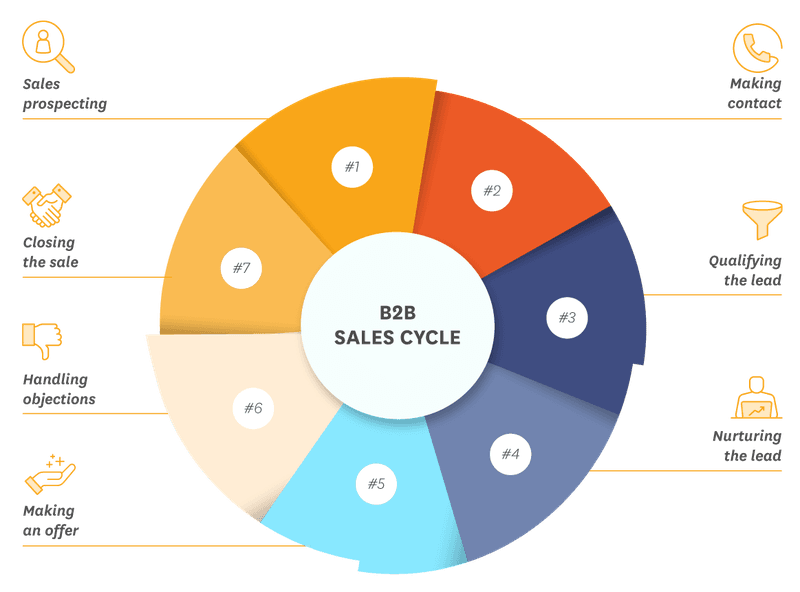

You may have been a salesman for a while but have not quite accumulated the sales process for the7 stages of the sales cycle. These stages are very necessary when it comes to evaluating sales efforts, training new sales reps, and increasing sales effectiveness.
A sales cycle is the process that outlines the entire selling process involving a series of steps. All the activities involved starting from lead generation to converting prospects into full-paying clients fall in the sales cycle stages. There is no fixed definition for it, but it involves all the stages associated with closing sales.
An effective sales cycle that is regularly analyzed and perfectly implemented can bring about a clean sales system with sustainable results.
You can effectively predict your future sales with elaborate information from your sales process. For instance, you can figure out which sales are likely to succeed by the way they are panning out or you can use the information for setting a sales target by identifying the number of sales made by your reps in a month.
Keeping track of the sales cycle stages helps in getting business insights that increase sales efficiency. Analyzing and comparing your sales cycle to the standard length shows if you are behind or ahead of your competitors so that you could take steps accordingly. A shorter sales cycle is better as it reduces the chance of your sale failing.
As the sales cycle stages are detailed when you break them up into small steps, you'll effectively be able to gather data. You can automate this data collection with the proper CRM (customer relationship management) tool. Suppose, you're using cold emails for prospecting and driving sales. If the CRM tool is integrated with it, you'll be able to identify the exact point where your sales fall through in your sales cycle. It shows you which steps in your sales cycle help to take the sale forward and which ones fail to. So, if you're on the lookout for such an email sending software that will automate your email sending process along with integrating CRM tool, email warmup, reply tracking, and many more features, OutreachBin is the perfect one for you. Build sales relationships without having to worry about managing multiple email accounts and campaigns with OutreachBin.
A detailed sales cycle will be like a blueprint or template of how new sales reps will go about their sales. This helps sales reps understand the process fully and allow lesser signs of error.
Knowing which stages of your sales cycle need more improvement, you can assign more teammates or time in those sectors. You could also eliminate projects that have a low ROI.

Now let's look at how you can build a perfect sales process for your business.
You may think that you know who your potential customers are, but creating an Ideal Customer Profile (ICP) can give you immense focus and you can gain new insights on your sales campaign from it. At first, create a basic ICP, which will be a fictional company based on real data that-
As you have your ICP set up, look into your potential leads. This prospecting for leads can also take the form of lead generation. Suppose, you have a function on your website where when anybody signs in on your website, you get notified with their information. As such, you can reach out to them as potential leads. Identifying potential leads depends on your unique requirements. But, you can search for them from social media sites like- LinkedIn and online databases like- CrunchBase.
After finding the ideal companies according to your preferences, compile a list of them for your sales team to contact and qualify.
The first thing you have to do to get your sales process for the sales cycle stages on track is to identify who your potential customers are. Classify your leads according to these 4 metrics:
After the initial qualification, you can look into additional qualifiers, all based on your company’s requirements, like- company growth, size, geography, and so on. Though you need to speak to your prospect yourself to qualify them, these are some good factors that'll help you to classify them during the initial research phase.

The third sales cycle stage is to qualify your clients which means to vet the lead as much as possible. Most of the qualifying is done during the first sales meeting.
This is a crucial step in qualifying your leads. If you are talking to the decision-maker, you'll be able to offer high value by identifying your opportunities as per your ICP. If they don't have the authority to make decisions in this regard, ask them to include a superior in the meeting politely.
Conduct researches to ensure if you can provide what your clients want, their budget, goals, challenges, and other such factors. This is the step to make sure that they meet the criteria mentioned above to further qualify them as leads. Also, you have to talk directly to your prospect to realize if they’re the right fit or not.
This sales cycle stage allows you to prove your relevance to your prospect.
At this point in the sales cycle stages, the ball is in the leads’ court. They know all the information about the product and your business, so it’s their call now. Usually, at this stage, you’ll face some objections from their side and you’ll have to be prepared for answering them.
Even the most enthusiastic leads will have some kind of hesitation or objections. What you need to do is, figure out the most common objections and ways on how to handle them. This way you’ll already be way ahead of the game. Of course, all the objections won’t be common to you, but you’ll be able to improvise them on your own.
We know objections can be hard to handle. But, handling these objections while alleviating the clients’ concerns is what makes someone a great salesman. Studies show that 44% of salespeople drop out after their first rejection, 22%, 14%, 12% drop out after their second, third, and, fourth rejection respectively. Though the chances of complete rejection from prospects are slim at this stage, you should still be prepared.
The earlier you handle your objections the better. Try to overcome the objections at the nurturing stage. Though, sometimes it’s not possible to handle them ahead of time.
Sometimes, your prospects won’t conspicuously tell you the reason for them being uninterested. You have to understand them yourself. Maybe they have had similar products or services before that didn’t work out for them or they’ve had some bad experience which they are afraid of happening again. To overcome these, ask them lots of questions about why they’re not interested, if they’re uninterested because of this or that. This will make them open up about their concerns and you can overcome them outrightly.
If they come up with an objection, follow these steps accordingly,
Provide them multiple solutions to their objections. Suppose their objection is about the price of your product or service. Now, you can explain to them the value of your product and how it’s worth the price tag it comes with. You could also rephrase the pricing information in a per-day breakdown. Like, if your service charges $200 a month, tell them it’s $6 a day! That’s less than a Starbucks drink.

That’s the last sales cycle stage. Now, this can go in a lot of ways.
After you’ve closed the deal, keep in contact with them and answer any remaining questions that they might have. After the in-person meeting, send an email with a summary of the conversation and agreement to their assistant.
Now that you know the basic outline of how you can arrange your sales process, tweak it and adjust it according to your experiences and what fits your customers best. So, that’s how you can curate the perfect sales process for the 7 stages of the sales cycle.





